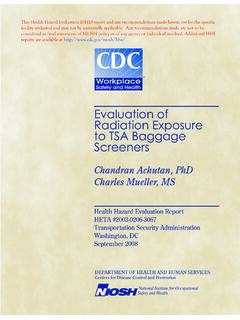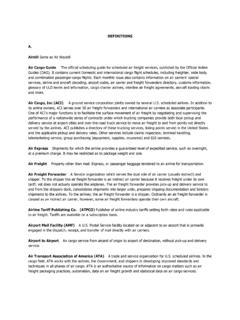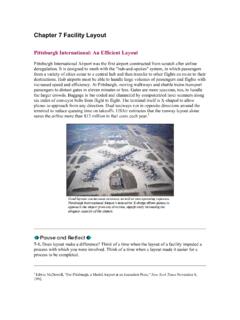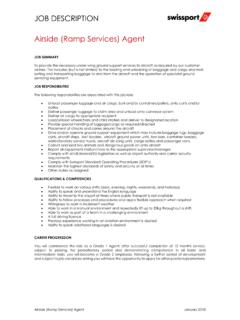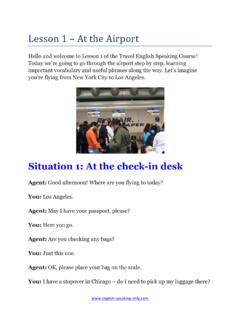Transcription of Denver International Airport - Baggage System - Case Study
1 Denver Airport Baggage Handling System Case Study Calleam Consulting Copyright 2008 Calleam Consulting Ltd, all rights reserved Case Study Denver International Airport Baggage Handling System An illustration of ineffectual decision making Calleam Consulting Ltd Why Technology Projects Fail Synopsis Dysfunctional decision making is the poison that kills technology projects and the Denver Airport Baggage System project in the 1990 s is a classic example. Although several case studies have been written about the Denver project, the following paper re-examines the case by looking at the key decisions that set the project on the path to disaster and the forces behind those decisions.
2 Background What was to be the world s largest automated Airport Baggage handling System , became a classic story in how technology projects can go wrong. Faced with the need for greater Airport capacity, the city of Denver elected to construct a new state of the art Airport that would cement Denver s position as an air transportation hub. Covering a land area of 140 Km2, the Airport was to be the largest in the United States and have the capacity to handle more than 50m passengers annually [1,2]. The Airport 's Baggage handling System was a critical component in the plan. By automating Baggage handling, aircraft turnaround time was to be reduced to as little as 30 minutes [1].
3 Faster turnaround meant more efficient operations and was a cornerstone of the airports competitive advantage. Despite the good intentions the plan rapidly dissolved as underestimation of the project s complexity resulted in snowballing problems and public humiliation for everyone involved. Thanks mainly to problems with the Baggage System , the Airport s opening was delayed by a full 16 months. Expenditure to maintain the empty Airport and interest charges on construction loans cost the city of Denver $ per day throughout the delay [3]. The embarrassing missteps along the way included an impromptu demonstration of the System to the media which illustrated how the System crushed bags, disgorged content and how two carts moving at high speed reacted when they crashed into each other [4].
4 When opening day finally arrived, the System was just a shadow of the original plan. Rather than automating all 3 concourses into one integrated System , the System was used in a single concourse, by a single airline and only for outbound flights [5]. All other Baggage handling was performed using simple conveyor belts plus a manual tug and trolley System that was hurriedly built when it became clear that the automated System would never achieve its goals. Although the remnants of the System soldiered on for 10 years, the System never worked well and in August 2005, United Airlines announced that they would abandon the System completely [6].
5 The $1 million per month maintenance costs exceeded the monthly cost of a manual tug and trolley System . System at a glance: 1. 88 Airport gates in 3 concourses 2. 17 miles of track and 5 miles of conveyor belts 3. 3,100 standard carts + 450 oversized carts 4. 14 million feet of wiring 5. Network of more than 100 PC s to control flow of carts 6. 5,000 electric motors 7. 2,700 photo cells, 400 radio receivers and 59 laser arrays Denver Airport Baggage Handling System Case Study Calleam Consulting Copyright 2008 Calleam Consulting Ltd, all rights reserved Chronology of events: Denver International Airport (DIA) Baggage System Development Timeline [1, 2, 3, 4, 5, 6] Nov 1989 Work starts on the construction of the Airport Oct 1990 City of Denver engages Breier Neidle Patrone Associates to analyse feasibility of building an integrated Baggage System .
6 Reports advises that complexity makes the proposition unfeasible Feb 1991 Continental Airlines signs on and plans on using Denver as a hub Jun 1991 United Airlines signs on and plans on using Concourse A as a hub Jun 1991 United Airlines engages BAE Systems to build an automated Baggage System for Concourse A. BAE was a world leader in the supply, installation and operation of Baggage handling equipment Summer 1991 Airport s Project Management team recognizes that a Baggage handling solution for the complete Airport was required. Bids for an Airport wide solution are requested Fall 1991 Of the 16 companies included in the bidding process only 3 respond and review of proposals indicate none could be ready in time for the Oct 1993 opening.
7 The 3 bids are all rejected Early 1992 Denver Airport Project Management team approach BAE directly requesting a bid for the project Apr 1992 Denver Airport contracts with BAE to expand the United Airlines Baggage handling System into an integrated System handling all 3 concourses, all airlines, departing as well as arriving flights. In addition System is to handle transfer Baggage automatically. Contract is hammered out in 3 intense working sessions Aug 1992 United Airlines changes their plans and cuts out plans for the System to transfer bags between aircraft. Resulting changes save $20m, but result in a major redesign of the United Airlines portion of the System .
8 Change requests are raised to add automated handling of oversized Baggage and for the creation of a dedicated ski equipment handling area Sep 1992 Continental requests ski equipment handling facilities be added to their concourse as well Oct 1992 Chief Airport Engineer, Walter Singer dies. Mr Singer had been one of the driving forces behind the creation of the automated Baggage System Jan 1993 Change orders raised altering size of ski equipment claim area and adding maintenance tracks so carts could be serviced without having to be removed from the rails Feb 1993 Target opening date shifted from 31 Oct 93 to 19 Dec 93 and soon thereafter to 9 Mar 94 Sep 1993 Target opening date is shifted again.
9 New target date is 15 May 1994 31 Oct 1993 Original target for opening 19 Dec 1993 Second target for opening Jan 1994 United Airlines requests further changes to the oversize Baggage input area 9 Mar 1994 Third target for opening Mar 1994 Problems establishing a clean electrical supply results in continual power outages that disrupt testing and development. Solution requires installation of industrial filters into the electrical System . Ordering and installation of the filters takes several months Apr 1994 Airport authorities arrange a demonstration for the System for the media (without first informing BAE). Demonstration is a disaster as clothes are disgorged from crushed bags Apr 1994 Denver Mayor cancels 15 May target date and announces an indefinite delay in opening May 1994 Logplan Consulting engaged to evaluate the project 15 May 1994 Fourth target for opening May 1994 BAE Systems denies System is malfunctioning.
10 Instead they say many of the issues reported to date had been caused by the Airport staff using the System incorrectly Aug 1994 System testing continues to flounder. Scope of work is radically trimmed back and based on Logplan s recommendation Airport builds a manual tug and trolley System instead Aug 1994 City of Denver starts fining BAE $12K per day for further delays 28 Feb 1995 Actual opening Aug 2005 In order to save costs the System is scrapped in favour of a fully manual System . Maintenance costs were running at $1M per month at the time. Denver Airport Baggage Handling System Case Study Calleam Consulting Copyright 2008 Calleam Consulting Ltd, all rights reserved Basic Mode of Failure As with all failures the problems can be viewed from a number of levels.
